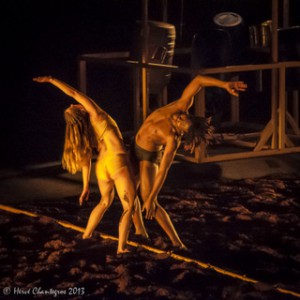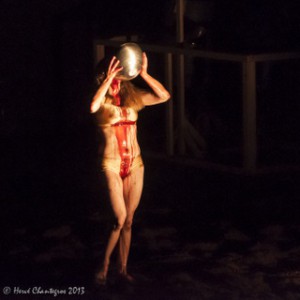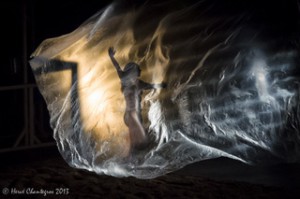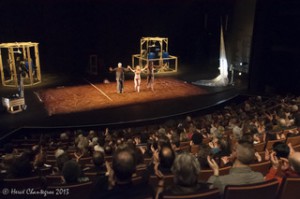Sunday
Arts and Poetry, Regional AnnouncementsM’Bongui
M’bongui , a dance performance with music composed by Herbert Elsky and choreography by Sophie Fougère-Darcy, took place on February 15th at the 300 seat Mégisserie theater in St Junien (Limousin, France).
M’bongui is a traditional Congolese dance ceremony that was practiced before and after a hunt. Before the hunt, it was believed that the hunters would put themselves in serious danger and they could possibly be killed if they didn’t do the dance and connect with the spirits of the animals. The dance after the hunt was to share the animal as an offering to the community, and to show gratitude (for the animal).
A l’origine, en Afrique centrale, « Mbongui » signifie l’assemblée, lieu de rassemblement où les habitants d’un village par exemple se retrouvent pour partager le produit d’une chasse et remercier par l’intermédiaire de danses rituelles l’animal de son sacrifice. Il y a ainsi une passerelle avec le théâtre également lieu de rassemblement. Mbongui est un spectacle conçu pour sacraliser ce passage d’un lieu froid, de mort (abattoir) à un lieu chaud, de vie (théâtre).
This performance was inspired by a conversation with the director of the Mégisserie Theater, Olivier Coqueberg, in the salle d’exposition, previously the abattoir (slaughter house) for St Junien. The building has been renovated to become a beautiful theater and exhibition complex. He said, « There is the blood of thousands and thousands of animals in the ground here and a feeling of disconnection between what this place was in the past and what it is now. »
Cette création est née d’un échange entre Olivier Couqueberg, directeur de La Mégisserie et Sophie Fougère Darcy, chorégraphe. Une réflexion à partir du sang de milliers d’animaux versé sur le sol de l’ancien abattoir de La Mégisserie et un sentiment de décalage entre ce qu’était ce lieu par le passé et ce qu’il est aujourd’hui. « Notre intention est de créer une danse qui ramène la paix aux esprits des animaux qui furent abattus ici comme à ceux des personnes qui travaillèrent dans l’abattoir. Notre souhait est de leur rendre hommage et de célébrer la transformation de cet espace vers ce qu’il est aujourd’hui. » Sophie Fougère- Darcy
I suggested that we could do a ceremony to harmonize the energy of the place. Then together with Sophie, Bobby and Philippe, we began talking about creating a dance ceremony with Sophie Fugère-Darcy as the choreographer, Bobby Mfoumou and Marylis Soudanas as the dancers, and Philippe Darcy as the sound and lighting engineer. We would use my “musical structures” to create rhythms for the Mbongui dance plus a recorded sound track that I made for the dance duo.
Un magicien, un compositeur, un majordome ? Un homme s’avance calmement et met en mouvement le monde, de bois, de métal, de cordes, de bidons, de plastique, d’eau et de vent. Un monde de bric et de broc comme le nôtre, qui tourne et qui chante. C’est l’aube, le premier jour, les animaux et les hommes sont si proches, puis tout se sépare… Au milieu des sculptures vivantes et impressionnantes d’Herbert Elsky, Bobie Mfoumou et Mailys Soudanas dansent les premiers pas, les premiers cris et amours, les trahisons…
Our intention was to create a Dance Cérémonie to bring peace to the spirits of the animals who were slaughtered here as well as the people who worked here, to honor them, show appreciation for their lives, and to celebrate the transformation of the place into what it is now.
In theses days of industrialized globalization we buy our pieces of meat packaged in plastic and we may not even know which country it comes from. We are ignorant about how the animals are raised and how they are killed. They are just another product for consumption.
We have forgotten something extremely important, the sacredness of these other beings. In earlier times and in other cultures, animals were respected and appreciated. They were invoked as helpful spirit guides having different kinds of powers that we could connect to. These powers could be of benefit for healing, seeking wisdom, and for prophecy. In particular for the Native Americans, animals like the buffalo and the eagle, were seen as messengers between the Creator and humans on earth.
The Native Americans were very grateful people who held special ceremonies to pray and offer thanks to their spirits. They believed that everything in this world had a spiritual power—plants, animals, rocks, trees, mountains… everything! Because of this belief, they only took what they needed from the land and were never wasteful.
The Native Americans believed totally in the power of animal spirits and the spirits of each other. They worshipped animals as ancestors, imitated them in dance, and told myths about them. These animal legends were passed down from generation to generation.
The smoke ceremony
As part of the performance, I did a smoke ceremony which is something that is traditional to many indigenous cultures. It is called a lhasang which literally means “divine purification.” As the juniper incense is offered to the fire, the smoke rises up purifying obstacles and negativity while bringing blessings to the place and the people.
The Sound Track for the Dance
The raising of livestock is an important part of the economy in the Limousin area where I live. Each year when the calves are old enough, they are taken away from their mothers. As a result, the mothers call for their babies for two days and nights. It is a cry full of powerful emotion.
The main part of the sound track is based on the cries of the mother cows when they are separated from their calves. This primordial cry expresses the deep feeling of separation and the sense of loss.
I was especially moved by this calling of the mother cows as our house is located just next to the field where the cattle are kept. We could hear the calling voices all day and night and I was inspired to record their voices. That recording became the basis for the sound track for the dance. I manipulated the voices of the cows by slowing them down and speeding them up to give the feeling of the intensity of the experience.
Through this experience the audience also acknowledges the deep wound revealed when a primordial bond we have with another is broken. In acknowledging that feeling, the audience becomes part of the transformation.
By Herbert Elsky
Pictures by Hervé Chantegros
Para leer esta infomación en español: http://shambhala.es/newsletter_details.php?id=2521






















Mar 4, 2013
Reply
Wow!!! This is beautiful!
Even just reading about it is extremely touching.
I so wish I had been there…
But such is the nature of art sometimes…. So ephemeral.